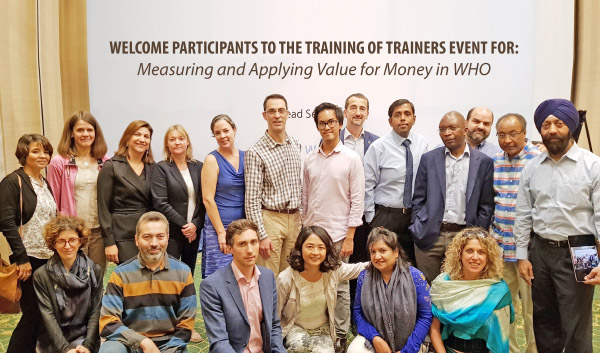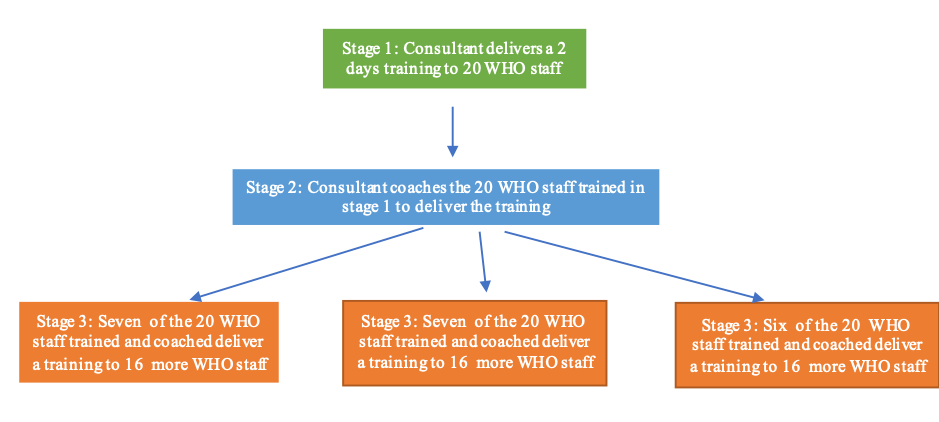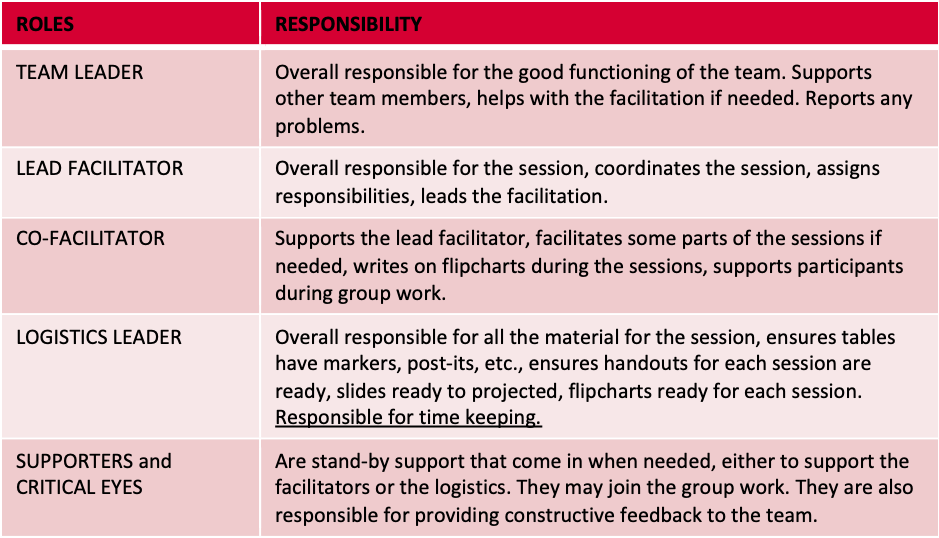Introduction
In September 2018, I was asked by BOND to adapt the London-based training ‘Putting Value for Money (VfM) into Practice’ to the needs of the UN World Health Organization (WHO). WHO had already developed a Corporate VfM strategy which includes the provision of a quality training to staff working in 3 project hubs. As a result of the training, WHO expected to create a cross functional network of VfM Champions who could advise, influence and coach colleagues to adopt and implement a VfM approach.
So, rather than delivering a standard training on VfM, I agreed to design and deliver an innovative model of Training of Trainers (ToT) that would provide WHO , by the end of the two weeks, with approximately 40 “VfM Champions” and 60 trainees (named VfM “End users”), resulting in the training of approximately 100 staff members, with a potential of reaching up to 180.
In this post I share the approach developed, highlights of the content of the training, the structure, key learning and participants feedback.

The Week 2 WHO VfM Champions
The Approach
Based on previous experience, I proposed a ToT model made up of four stages that would enable the future WHO VfM trainers – the ‘VfM Champions’ – to practise the delivery of the 2 days training with other staff members. This would enable them to acquire confidence on the topic and gain experience in delivering the training.
The ToT was delivered across five days and was repeated in Week 2.
On days 1 and 2 the 20 VfM Champions attended a two-day VfM training delivered by myself.
On Day 3, the 20 VfM Champions were split into three groups and were coached to deliver the training to three new cohorts of trainees, assigning specific roles to each Champion. The ideal number for each new cohort is of between 16-20 people.
On days 4 and 5, the VfM Champions delivered 11 of the 17 sessions they had themselves attended on days 1 and 2 to the three groups of new trainees (the ‘End-Users’).
I continued to deliver the first and last two sessions every day to enable end users to ask any challenging questions that the VfM Champions may have required support to respond to. At the same time the VfM Champions acquired confidence and ownership over the training content by delivering it to the new cohorts of End-Users.
 Structure of the Training of Trainers
Structure of the Training of Trainers
The Two-Day VfM Training
The Two-Day VfM Training is an expanded and tailored version of the one-day training ‘Putting Value for Money into Practice’ which I deliver at the BOND Studio in London twice a year. The 2-day VfM Training is structured in 7 complementary modules aimed at sharing techniques and tools for VfM analysis at proposal and implementation stages of the programme cycle and for reporting purposes:
Module 1 is an introduction to VfM, in this case in the context of WHO, providing an overview of WHO’s VfM Strategy, its objectives and the implementation plan.
Module 2 introduces the participants to the concept of VfM, includes activities to analyse power dynamics when analysing VfM and provides highlights of DFID’s 4Es Framework (5Es in the case of WHO).
Module 3 focuses on the preparatory work and tools for analysing VfM during proposal development. This includes sharing tools for setting a VfM Framework of a proposal, assessing the evidence of the value and feasibility of the proposal, analysing the financial and non-financial resources and undertaking a desk-based VfM assessment of a proposal.
Module 4 is delivered at the beginning of Day 2 of the training and includes a recap of the key learning points of Day 1 as well as a facilitated discussion about the VfM agenda and the aspects that WHO in this case needs to take into account when developing its own approach.
Module 5 focuses on VfM during programme implementation. Participants are introduced to participatory VfM analysis and practise the use of tools that can be used to enable beneficiaries to assess the VfM of an organization’s programme. It also includes an activity about using VfM for adaptive management during programme implementation.
Modules 6 provides participants with two different models to report on VfM and enables the attendees to brainstorm the key themes to be included in each section of a VfM report.
Module 7 is the conclusion of the training. This is a space provided for participants to discuss what they learnt in the training and which tools and concepts they may take forward in their organizations or departments.
The training uses participatory and interactive techniques focused on enabling participants to practise the use of VfM tools, using a case study. In this case, I asked WHO to provide me with a project document, complete with a Theory of Change, logical framework, activity based budget. This I readapted and simplified and used to develop the tools to be used during the training. In this way, the training became practical and participants were able to relate to examples they were familiar with.
By the end of the training, participants were able to:
• Explain what VfM means and describe the 4Es framework (in this case WHO’s 5Es framework)
• Develop a VfM framework and assess different programmatic options
• Analyse VfM in proposals
• Use participatory VfM analysis to adapt programmes
• Explain the key themes to be included in VfM reports based on the 4Es framework (in this case WHO’s 5Es framework) and other approaches.
The Coaching Day (Day 3)
The Coaching Day is designed specifically to prepare the VfM Champions for the facilitation of the two-day VfM training, reviewing the training content and structure, providing a space to address any issues that arose in the previous two days and allow participants to prepare their respective sessions.
During the day, I provide a structure for the 3 facilitating teams; we review, in a structured way, the sessions they will facilitate; the VfM Champions prepare the material they require to facilitate the sessions; and the day is concluded with a series of facilitation tips to aid the effective delivery of the training.
Each member of the facilitating teams (7 people in each team in this case) are assigned specific roles in each session and each team is assigned a team leader. The responsibilities are described in Table 1.

The facilitation is organized so that every member of the facilitation teams is a lead facilitator of at least one session throughout the 2 days and stronger facilitators may be required to be lead facilitators for more than one session.
In addition, in the Coaching Day the VfM Champions receive all the relevant material which includes:
– A Facilitators Overview – a brief description of the timing of each session, the contents, the structure, the learning objectives and the material required;
– Facilitators Notes – a step-by-step guidance for the delivery of each session;
– A PowerPoint Presentation with all the slides used during the training;
– A list and description of the flipcharts to be prepared;
– All the handouts needed for the facilitation.
Learning from the experience
Overall, I was very satisfied with the experience of testing an innovative training model that can help organizations roll-out new concepts and approaches, building the confidence and capacity of leaders who can replicate what they learnt in a sustainable way.
Below are some reflections on the training model.
Criteria for the selection of the VfM Champions. The successful delivery of the training is dependent on the selection of the VfM Champions. In this case, the organizers asked different WHO offices and departments to select nominations. This meant that some VfM Champions were required to do the training by their supervisors or in other cases the nominated VfM Champions did not have jobs that would entail the replication of this training. In order to maximize the benefits of this type of training, it is advisable to further select VfM Champions who will be engaged in taking the organizational approach to VfM further. It is also essential that the criteria for the selection of the VfM Champions includes prior experience in facilitation of workshops and trainings as the ToT is not intended to cover facilitation skills.
Number of participants. In this case, each ToT was addressed to 20 VfM Champions and between 25 and 30 End-Users each week. This type of training requires a minimum of 12 VfM Champions and 36 End-Users up to a maximum of 21 VfM Champions and 72 End-Users. This is because the training is designed to enable participants to work in 4 groups and each group requires between 3 and 6 people for the discussion to be fruitful. It is also logistically challenging to coach and organize more than 7 VfM Champions in each facilitating team.
Logistics arrangements. This type of training is logistically quite challenging as it can involve, at some stages, up to 93 participants in different roles (facilitators, end-users, etc.). It is essential to ensure that administrative support is provided throughout the 5 days to address any issues arising and to deal with all the necessary materials required, such as the print-outs for each facilitation team, the laptops and projectors, stationary, etc.
The contents of the training. In this case, the training was designed to provide participants with a set of tools and techniques that they can choose from to implement VfM at different stages (proposal, implementation and reporting stages). This type of training may be even more appropriate once the organization has selected the basket of tools that they wish to use for the organizational approach. In this case, the training is less a general introduction to VfM but rather a specific training for the roll-out of the specific tools that the organization will adopt going forward.
The selection of the case study. The case study is the key tool used during the training to make it practical and hands-on. It is advisable that organizations wishing to deliver this type of training select an example of a project that participants can relate to but that they have not directly been involved in. This allows participants to engage with the case study critically while having a prior understanding of the nature of the programme and its approach.
The role of the Lead Trainer. As Lead Trainer, I had to ensure that the VfM Champions felt confident enough with the use of the tools to share their understanding with others, while giving a chance to End-Users to be able to ask more challenging questions. I therefore structured the last two days in such a way that enabled all participants to be together at the beginning and end of each day where they could ask questions and share reflections on what they had learnt. At the same time, I developed my own schedule to join the different facilitation teams on a rotational basis to clarify any outstanding points at the end of each session.
The nature of the training. The training was successful because of its contents. It is not a theoretical training but rather a hands-on one, focused on the use of VfM tools. This means that the VfM Champions were not required to know the theoretical background about VfM but rather concentrate on sharing with others the tools they had learnt in the first two days. The tools are simple enough to be understood fairly quickly and the fact that they were required to train others meant that the VfM Champions had to gain an in-depth clarity of each tool and ownership of the use of them, which significantly increased their learning experience.
Participants comments
Overall, the training model was very well received by both the participants and the organizers. On average, the usefulness of the training was rated between 8 and 9 out of 10 by the participants.
Below are some of the comments received in the evaluation forms:
“I liked the way the training was delivered – extremely participatory and fun”
<p”>“Giving the training myself helped concretise the subject matter”
“The tools were very good”
“As a result of the training we shall be more accountable and transparent with regards to the resources we have received and to the beneficiaries”
“I liked the hands-on practice as trainer”


Social Contact